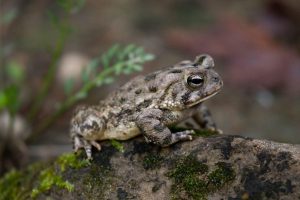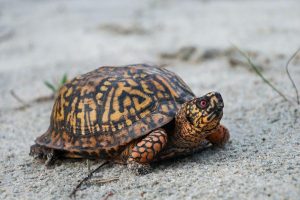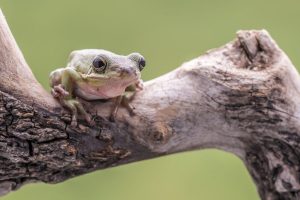
Wood Frog
Lithobates sylvaticus
This is one of Delaware’s earliest-breeding frogs during the springtime. It is found predominantly in pools situated within wooded wetlands.
South Delaware's
Reptiles & Amphibians
Wood Frog
Lithobates sylvaticus
This is one of Delaware’s earliest-breeding frogs during the springtime. It is found predominantly in pools situated within wooded wetlands.
Spotted Turtle
Clemmys guttata
This is a globally threatened species of turtle. Evolutionarily speaking, it is quite ancient and is the only extant species of its genus, Clemmys.
Southern Leopard Frog
Lithobates sphenocephalus
This is a common frog in many Delaware wetlands. It is named for the leopard-like spots on its body, which can range from brownish to vibrant green.
Painted Turtle
Chrysemys picta
This turtle is named for the brilliant yellow and orange markings on its head and neck. It is found in freshwater bodies, where it feeds on a variety of aquatic plants and animals.
Northern Red-bellied Cooter
Pseudemys rubriventris
This species grows much larger than the painted turtle and may be over a foot wide. Adults have a dark black head and visible redness on the bottom of the shell.
Green Frog
Lithobates clamitans
This large frog appears in varying shades of green. Its alarm call is likened to the plucking of a loose banjo string.
Fowler’s Toad
Anaxyrus fowleri
This toad is very common throughout Southern Delaware. It may be identified by its lumpy shape and mottled gray body.
Eastern Hognose Snake
Heterodon platirhinos
This non-poisonous snake may vary in color but has dark bands across the width of its body. When threatened, it will flatten its head to appear more menacing.
Eastern Fence Lizard
Sceloporus undulatus
This small gray or brown lizard lives throughout Delaware. It is often found in brush piles and, being very quick, is somewhat difficult to spot.
Eastern Box Turtle
Terrapene carolina carolina
This turtle is named for the closeable hinged flap with which it protects its head while hidden inside its shell. In captivity, box turtles have been known to live for more than 100 years.
Cope’s Gray Treefrog
Hyla chrysoscelis
This treefrog is distinguishable from the Gray Treefrog, found in Upstate Delaware, by its slightly different call. Its color varies greatly, ranging from mottled gray to almost entirely pale green.
Common Snapping Turtle
Chelydra serpentina
This is Delaware’s largest turtle. It typically weighs well over 30 pounds at adulthood and may be aggressive when encountered on land.
Common Five-lined Skink
Plestiodon fasciatus
Males of this species boast a bright blue tail and five distinct yellow-to-white lines down the length of their body. The females are larger than the males and sport a red head and less distinct lines.
Carpenter Frog
Rana virgatipes
Uncommon in Delaware, this species is known for its distinctive “clack-clack-clack” call, which sounds like a carpenter hitting a board with a hammer.
American Green Tree Frog
Hyla cinerea
This species is not uncommon throughout Delaware. It has a longer, more slender body than the Gray Tree Frog. It tends to be a vibrant green-to-yellow color.
American Bullfrog
Lithobates catesbeianus
This is Delaware’s largest frog species. It is a common sight around many bodies of water, including ponds, swamps, creeks, and canals. Bullfrogs are ambitious predators. Indeed, rodents and birds have even been found in their stomachs.
Looking for a vacation rental…
Make the most of your visit to Southern Delaware with Jack Lingo, REALTOR®. Find some of the best vacation rentals from across Lewes and Rehoboth, DE, and take your trip in style.
Find out morePlan your visit
Handy information to make your stay easy, safe, and enjoyable















